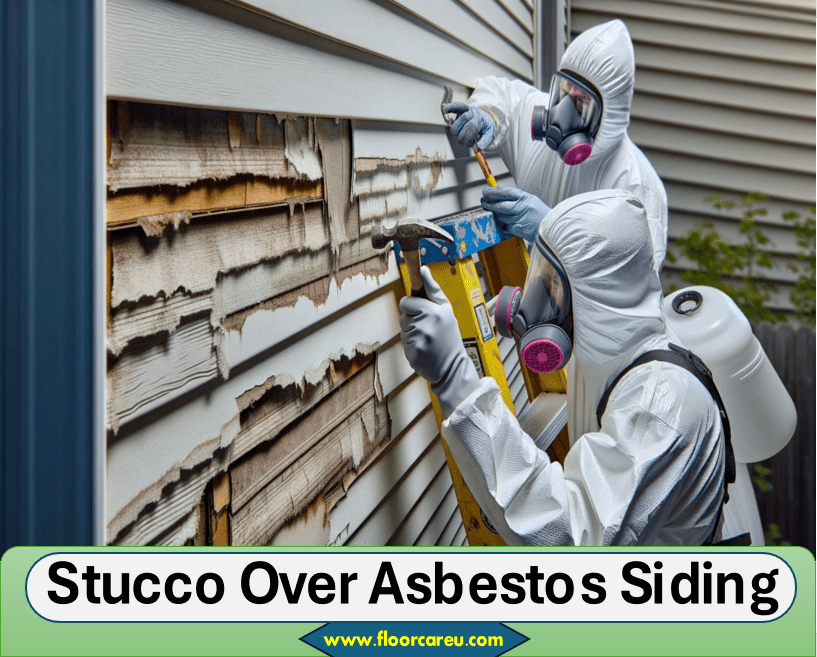Stucco Over Asbestos Siding: Stucco over asbestos siding can be risky and may lower the value of your property. It’s essential to address the asbestos issue properly before considering stucco installation.
Asbestos siding, commonly found in older homes, requires careful handling due to potential health hazards. While stucco offers an appealing exterior finish, covering asbestos siding with stucco is not advisable without first addressing the asbestos. This process can be complex, and seeking professional advice to handle the situation effectively is crucial.
Understanding the potential risks and limitations of dealing with asbestos siding and stucco can help homeowners make informed decisions regarding their property’s exterior. Consult with asbestos removal experts and discuss the best action for your situation.
Is Stucco Over Asbestos Siding Safe?
Covering asbestos siding with stucco can be a safe solution if the asbestos material is intact. Proper care is recommended for damaged areas. Seek advice from professionals before considering stucco over asbestos siding.
Assessing The Condition Of Asbestos Siding
Before considering stucco application over asbestos siding, it’s crucial to assess the current condition of the siding. Look for any signs of damage, deterioration, or wear that may pose a risk.
Inspecting the asbestos siding will help determine if it is safe to proceed with the stucco application or if repairs or removal are necessary for the safety of occupants.
Considerations Before Stucco Application
When planning to stucco over asbestos siding, important considerations must be made to ensure the occupants’ safety and the structure’s integrity.
- Consult with professionals experienced in handling asbestos materials.
- Ensure proper ventilation and safety measures during the stucco application process.
- Obtain necessary permits and approvals for the stucco installation over asbestos siding.
Considering these factors before proceeding with the stucco application can help mitigate potential risks associated with asbestos exposure.

Methods Of Handling Asbestos Siding
When handling asbestos siding, it’s crucial to prioritize safety and compliance with regulations. Asbestos-containing materials should be cautiously approached, and proper procedures must be followed to mitigate health risks. There are various methods of dealing with asbestos siding, each with its considerations and implications. Let’s explore some of these methods in detail:
Covering Asbestos Siding With Stucco
One approach to handling asbestos siding is to cover it with stucco. Stucco application over asbestos siding can encapsulate the hazardous material, providing additional protection while enhancing the exterior’s appearance. This method requires meticulous preparation and adherence to safety guidelines to ensure the proper encapsulation of the asbestos fibers.
Alternatives To Stucco Application
If stucco application is not a viable option or if there are concerns about its effectiveness, there are alternative methods for addressing asbestos siding. These alternatives may include repairing damaged areas, replacing the siding with non-asbestos materials, or encapsulating the siding with specialized coatings. Each alternative has its considerations and may require a professional assessment to determine the most appropriate action. It’s essential to consult with experienced professionals to evaluate the best approach for handling asbestos siding based on the specific circumstances.
Best Practices For Stucco Over Asbestos Siding
Following proper preparation steps and ensuring regulatory compliance is crucial when stuccoing over asbestos siding. Proper preparation ensures a smooth stucco application and helps minimize the risk associated with asbestos. This article will discuss the best practices to follow when stuccoing over asbestos siding, including proper preparation steps and ensuring regulatory compliance.
Proper Preparation Steps
Before applying stucco over asbestos siding, it is important to adhere to the following preparation steps:
- Assessment: Start by assessing the condition of the asbestos siding. If the siding is damaged or deteriorating, it is recommended to consider alternative options, such as removal or repair. However, stucco application may be viable if the siding is in good condition.
- Cleaning: Before applying stucco, the asbestos siding should be thoroughly cleaned to remove dirt, dust, or debris. A soft wash system is safe and effective for this purpose.
- Repairing: Any damaged areas or loose pieces of asbestos siding should be carefully repaired or replaced. This ensures a solid foundation for the stucco application.
- Sealing: To prevent the potential release of asbestos fibers, it is recommended that a layer of encapsulating sealer be applied over the asbestos siding. This helps to contain the asbestos and provides a barrier between the siding and the stucco.
- Priming: Before applying the stucco, it is important to prime the asbestos siding. This helps the stucco to adhere properly and provides a better finish. Use a primer specifically designed for asbestos surfaces.
Following these proper preparation steps can ensure a successful stucco application over asbestos siding.
Ensuring Regulatory Compliance
When dealing with asbestos, it is essential to ensure regulatory compliance to protect yourself, your family, and the environment. Here are some important regulatory practices to adhere to:
- Obtain necessary permits: Before starting any stucco work, check with your local regulatory authority to determine whether permits are required. This ensures compliance with local building codes and regulations.
- Hire a licensed professional: It is recommended to hire a licensed contractor who has experience working with asbestos-containing materials. They will have the knowledge and expertise to handle the project safely and correctly.
- Use proper protective equipment: When working with asbestos, it is vital to wear appropriate personal protective equipment (PPE), such as a respirator with a HEPA filter, gloves, goggles, and disposable coveralls. This helps to minimize the risk of exposure to asbestos fibers.
- Proper disposal: Asbestos-containing materials should be disposed of according to local regulations. Contact your local waste management authority for guidance on proper disposal methods.
By ensuring regulatory compliance, you can mitigate the potential health risks associated with asbestos and ensure a safe and legal stucco application.
Challenges And Drawbacks
Stucco over asbestos siding poses challenges due to potential asbestos exposure risks during application and long-term maintenance. Cutting or washing asbestos siding requires caution to avoid fiber release. Assessing the condition and seeking professional advice before considering the stucco application is advisable.
Maintenance Considerations
When it comes to stucco over asbestos siding, there are several challenges and drawbacks that homeowners need to consider. One of the main concerns is the maintenance required for this type of siding. Stucco is a durable and low-maintenance material, but it can be more difficult to maintain when applied over asbestos siding. Here are some maintenance considerations to keep in mind:
- Regular Inspection: It is important to regularly inspect the stucco surface for any signs of damage, such as cracks or chips. Any issues should be addressed promptly to prevent further damage.
- Sealing and Repairs: Stucco can develop cracks over time, especially if applied over an existing asbestos siding. These cracks should be sealed to prevent moisture penetration and further deterioration. The underlying asbestos siding should be repaired carefully to avoid disturbing the asbestos fibers.
- Cleaning: Stucco can accumulate dirt, mold, and mildew over time. Regular cleaning is necessary to maintain the siding’s appearance and integrity. However, caution should be taken when using abrasive cleaning materials or high-pressure washing, as these can damage the stucco surface or release asbestos fibers.
Potential Long-term Risks
Despite the unique challenges of maintaining stucco over asbestos siding, there are some potential long-term risks associated with this combination. These risks include:
- Asbestos Fiber Release: In certain conditions, such as during renovations or when the stucco surface becomes damaged, there is a risk of asbestos fibers being released into the air. These fibers can be hazardous if inhaled, leading to serious health issues such as lung diseases and cancer.
- Moisture Trapping: Stucco is a porous material that can absorb moisture. When applied over asbestos siding, there is a higher risk of moisture getting trapped between the layers, leading to mold and rot issues. Proper insulation and ventilation should be ensured to minimize this risk.
- Durability Issues: Asbestos siding is known for its durability, but when covered with stucco, the overall strength and resilience may be compromised. The stucco layer can develop cracks or chips over time, which can affect the performance and longevity of the siding.
In conclusion, while stucco over asbestos siding can be a viable option for homeowners, it is essential to be aware of the challenges and drawbacks involved. Proper maintenance, regular inspections, and caution during repairs are crucial to ensure the safety and longevity of the siding. Additionally, it is advisable to consult with professionals with experience working with asbestos-containing materials to mitigate any risks.
Case Studies And Expert Opinions
Understanding the process and considerations of stucco over asbestos siding can be better comprehended through real-life examples and insights from industry professionals. Let’s delve into some case studies and expert opinions to understand this topic better.
Real-life Examples
When considering stucco over asbestos siding, it is crucial to understand real-life examples. When asbestos-containing roofing and siding are in good condition, it is typically recommended to leave them undisturbed. Damaged roofing and siding should be carefully repaired. Sometimes, asbestos-containing roofing and siding can be covered with new materials. This highlights the importance of assessing the condition of the asbestos siding before applying stucco.
Insights From Industry Professionals
Insights from industry professionals can provide valuable information when considering stucco over asbestos siding. According to experts, following specific guidelines when dealing with asbestos siding is essential. For instance, when it comes to cutting asbestos siding, it should be done using proper tools to minimize the release of fibers. Also, asbestos siding should be cleaned using appropriate techniques, such as softwash systems.
Frequently Asked Questions On Stucco Over Asbestos Siding
Is It OK to Cover Asbestos Siding?
Covering asbestos siding is okay if it’s in good condition; damaged parts should be repaired. In some cases, it can be covered with new materials.
Can Asbestos Be In Stucco?
Stucco itself does not contain asbestos, but asbestos could be present in underlying materials.
Can You Cut Into Asbestos Siding?
Cutting into asbestos siding is not recommended. If cutting or repairing asbestos shingles is necessary, it should be done with a shingle cutter or scored with a carbide knife. Using an abrasive saw can release harmful fibers. It is important to wear a respirator with a HEPA filter.
Can You Wash Asbestos Siding?
Yes, softwash systems work well for cleaning asbestos siding. Power washing can be safe but should be done cautiously to avoid releasing fibers.
Can Stucco Be Applied Over Asbestos Siding?
Applying stucco over asbestos siding is possible, but it is not recommended due to potential hazards and difficulties in the process.
Conclusion
When considering stucco over asbestos siding, it’s vital to prioritize safety and thorough inspection. Understanding the potential risks and ensuring proper handling can prevent unnecessary complications. Seek professional guidance to assess the condition of the siding and make informed decisions about the stucco application.
Prioritizing safety and proper procedures is essential when dealing with asbestos materials.


